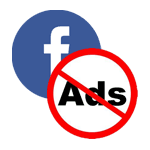
Facebook, just like any (if not all) content-generated free-to-use-and-see service of the web, needs to make money somehow. And the most obvious is by using ads. Many people don't care because Facebook's native ads blend well to the rest of the design and content. While some may like ads, many don't. And that include ad-blockers.
Facebook and ad-blocking software are always against each other.
On August 9th, 2016, the social giant announces that it will start ignoring desktop ad blockers. While Facebook's mobile users are increasing in numbers, desktop users are still making a big part of the overall users' visit. Facebook needs to make money, so this isn't surprising.
To do this, Facebook is tweaking the way how it shows ads, and allowing users to control ads shown on their News Feed with a revamped ad controls.
The change starts with a simpler set of advertisement preferences. Tapping 'why am I seeing this?' on the right corner of an ad will provide information about why the user is targeted with that specific ad. This could range from age, occupation, location or interest. Users can also access the 'Manage your ad preferences' to do more changes. For example, they can ignore certain ads, or to stop seeing ads from companies of their choice.
In short, Facebook allows a more easier way for users to specify the types of ads they prefer to see.
With more customization, Facebook is acknowledging that many people use ad-blockers to stop annoying and disruptive ads. So here Facebook wants to give the power back to user, allowing them to see what ads they want to see so they won't need to block them.

What's good for users should be good for Facebook? As a matter of fact, that is not necessarily true. According to Adblock Plus (ABP), Facebook is taking the "dark path" against users' choice by "trying to circumvent users with ad-blocking software and show them ads."
On August 11th, the open-source community behind the EasyList filtering mechanism - a filtering tool used by multiple ad-blockers - detailed a crowdsourced fix that aims to counter the new way Facebook tries to show ads by encoding them differently to sneak pass ad-blockers. The community reverse engineered it to find these encoded ads, and to again block them.
According to Adblock Plus spokesman Ben Williams:
But Facebook can find ways to counter such effort. The battle between advertisements and their blockers is sort of a back-and-forth battle between the creators and the haters. The attempt to block ads has been around since the start of ads being shown on the internet. Facebook can write some code to render the filter useless at any time they want. And as that happen, the ad-blocking community will find a workaround to the subject, and so will Facebook in circumvent again.
It's a cat-and-mouse game that will never end.
